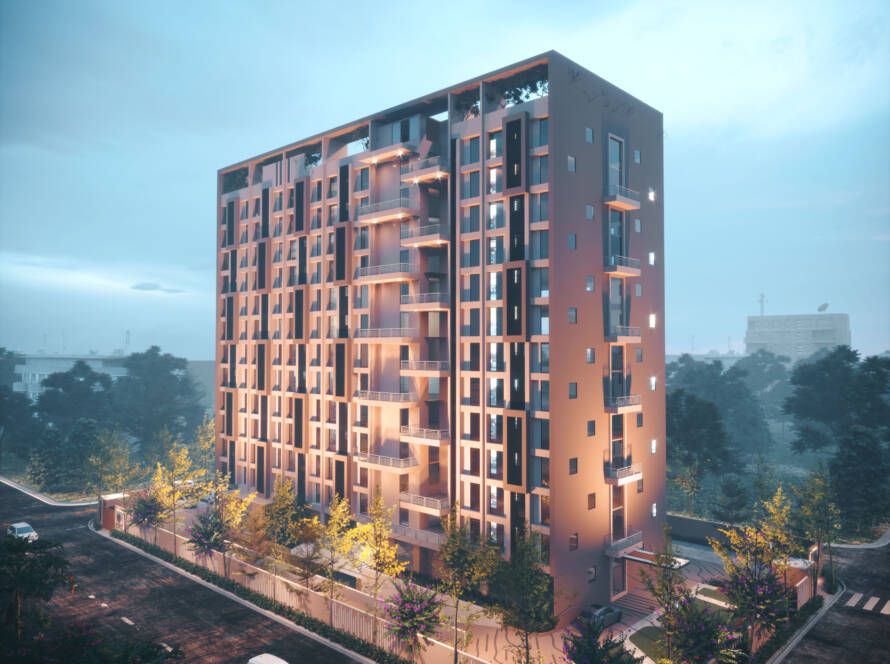One of the most important parts of creating 3D objects is visualizing them in 3D. It takes ability, knowledge, and artistry; thus, not everyone can accomplish it. Choosing the right 3D rendering project style is crucial if you want to render 3D objects or meet task requirements.
Simply getting started on the correct foot is worth more than 80% of the total effort. Having an organized concept and plan will make it easier to get things done correctly. To make the best choice, read our guide till the finish!
What is architectural 3D rendering?
The term “3D rendering” refers to a technique used in the field of architecture for the virtual construction of structures such as buildings, homes, and other dwellings. Designers use AutoCAD to create 3D images for others to assess. The designer needs rendering skills and an artistic sense to pull this off—3D rendering is art.
The need for 3D artists is rising quickly in several fields, including architecture. It’s because perfect 3D art takes talent and expertise. Every 3D architect must:
Understand their actions: The success of the 3D architect’s project depends on their in-depth familiarity with all aspects of rendering. An experienced eye can spot even the smallest errors.
Know the objectives: Not everyone can render freely. The artist’s task is to realize a set of predetermined goals for the design. They can range from being too complicated and specific to being too easy and tedious.
Do it right: People say, “If you are doing something, do it right,” which applies to 3D architects. Their work must be perfect, or the projects will never be completed.
3D rendering projects types
Here are some important architecture 3D rendering projects:
Exterior rendering: Many consider this style of depiction the most important. Basically, clients want to see the artificial appearance of their future home or apartment complex. The use of 3D rendering is one viable options
Interior rendering: Interior rendering is the second most popular. A room or residence will be rendered by the artists so the client may view the finished product. That way, people may provide input on potential improvements.
CG rendering: CG rendering is used to render items or designs that are difficult to build or don’t exist in the actual world. For special effects, filmmakers utilize CG rendering, while architects use it for advanced projects.
Animation: Understanding 3D animation is key. In this approach, clients may see the project from numerous angles, in motion, and in size. It is a prime example of 3D rendering’s practicality. Consider this.
What do you hope to accomplish with this project?
Setting a goal for 3D rendering is crucial. If you start over, you may make a mistake and have to redo the entire thing after hours of work. Defining a project goal and milestones is the most crucial step to avoid this.
You should plan this carefully to ensure success. If you accomplish this right, you can start your 3D project whenever you choose. You should also consider the project’s purpose, who it’s for, and how to integrate all the criteria. Keep your expectations low—starting something you can’t finish is meaningless.
You can succeed if you pay attention to the details of the client’s request or the specifications of the task. Remember that you have a deadline, so prepare beforehand.
How do you intend to promote your product?
Presenting your project to the market is crucial. You must create a viable idea before promoting it. Otherwise, complications may arise, and your project may not be known. If you are new to rendering, we recommend reading a guide or hiring a professional. In the long term, that will help you gain experience and establish a portfolio quickly.
When posting your project, make sure it reaches the intended audience. It’s important to consider who would be curious about your endeavor, who might be willing to lend a hand, and who might be interested in buying the finished product. Spending time on it without publishing it where others can find it is worthless.
Promoting your services and seeking clients and contacts to assist you in planning and executing your project is another option. Promoting your products requires marketing and contacts.
Your building’s size
Dimensions matter in architecture. It will show you if the project is practical, profitable, and can be completed on time. You should also consider that some countries and localities’ rules may prevent you from erecting such structures.
Not making architectural rendering mistakes is crucial, especially for freelancers. Misjudging your future project’s proportions will make it uncompetitive. Additionally, avoid recycling models when rendering. This can happen, especially on huge projects. Maintain simplicity and practicality while being unique enough to be good.
We suggest understanding 3D rendering tools before choosing a huge project. You can use advanced tools once you understand the basics. You can start creating enormous structures and gradually increase their size. Before starting, consider this.
Interior or exterior?
If you’re new to 3D rendering or modeling, study interior and exterior design. However, you may need to consider which one is more appropriate for your project’s clientele or duties.
Consider these when working alone:
- Focus on a task you can handle.
Being unable to finish a project is the worst and most frustrating. Thus, focus on initiatives you can finish. Meanwhile, practice rendering.
- Pay attention to details
Interiors and exteriors have many subtle differences. Most clients will tell you how many details they want in both forms of rendering, but you must still know how to fulfill them all. A competent 3D artist does that.
With or without animation?
Your project’s goal is determined. Play around to determine which model or render works best for your personal project. You can start offering them both alternatives once you master it, with or without animation.
Unless the clients specify, use your judgment to determine if animation will benefit the project. Hiring 3D rendering services provider might save you time and help you fulfill your deadline. Consider everything a client would want and make it enticing. It boosts project completion.
What should clients and stakeholders see?
You must consider what clients or stakeholders want when working on a project to sell. Then, start your rendering job and consider what the clients like and dislike.
Asking clients about their preferences and as many specifics as possible is an easier way to think like them. If you keep that in mind as you work, you’ll have happy clients and a more successful project. 3D artists should prioritize this.
You should also take plenty of notes on your conversations with clients. Take everything into account and create a project that will amaze them. You’ll get better with practice, so don’t give up!
Detail and realism
For product placement and customer satisfaction, realism and detail are essential. Another good suggestion is to discuss detail and realism with them. Make sure to present examples of your work that vary by field, and make sure you and your clients agree before starting the job.
Be aware that realism and detail are subjective. The number of details and realism layers in your project is up to you. It can be simple, semi-realistic, or realistic, so consider this before starting.
3D Interior Rendering: 12 Popular Styles Chosen by Arc Studio
CGI benefits are well-known to interior designers. This technology has revolutionized the industry. This is due to the fact that 3D rendering for interior design aids professionals in practically every aspect of the process. How so?
Pre-construction 3D renderings can show interior design projects. Instead of crude mood boards, CGI can generate photoreal, detailed results. Which means designers can easily help clients choose the ideal style for their home or apartment and receive project clearance. In addition, 3D visualization gives designers beautiful CG visuals for marketing and portfolios.
Designers should choose a 3D rendering company that can fully present a project. Arc Studio understands its relevance. Because of this, our 3D artists can produce outstanding CG visuals in any style. Also, we have a bespoke CRM system with many interior design 3D scenarios and models. The database can be used as a resource for designers to find ideas and completed elements for their work.
We categorized 3D models and settings into 12 categories to help our clients find goods in the right style. Wondering about interior design rendering styles? Our architectural rendering company’s 3D artists created all of the CG images. Enjoy and gather ideas for future projects!
Art Deco
Art Deco is a cultural phenomenon that transcends the realm of interior design. From France in the 1920s, it went worldwide. It peaked in the 1930s. Geometric shapes like triangles, squares, and rhombuses distinguish Art Deco 3D renderings. Interiors in Art Deco are vibrant and colorful. The colors are vivid blues, yellows, etc. Chrome or black usually complement those colors. Beiges and creams are also popular. Exotic materials, wood, animal prints, vintage furniture, marquetry, and modern artworks are also essential components of Art Deco interior design. This style is ideal for beautiful homes with unique furnishings.
Classic
The classic style originated in 17th-century Europe. Interior design 3D renderings show its Western classical influence. Classic interiors have symmetry, noble materials, and Greek and Roman characteristics. Such interiors have peaceful colors. Cream, beige, and somewhat greenish hues are included. Lighting dominates 3D renderings of classic designs. It should create a warm, harmonious atmosphere. Use enormous chandeliers, gorgeous lighting, or a fireplace. Self-confident, mature people who respect traditions and like sculptures, huge vases, etc. go for this interior style.
Contemporary
Contemporary art was created in the 20th century. Both constructivism and minimalism are significant influences. The use of inexpensive and functional furniture is a basic principle. Colors do not characterize modern interiors. Walls and flooring are neutral, yet furniture is vibrant and striking. This type of interior 3D modeling places more emphasis on space than ornamentation. Contemporary rooms feature bold, minimalist furniture. People who like simple, comfortable, and utilitarian houses adore this design.
French Country
French Country began in the 1600s. French farmhouses had an influence on this elegant style. It is stylish and welcoming, as shown in the 3D interior design rendering above. A warm palette includes creams and tans. Materials like wood are used for furniture and accessories. Nearly every 3D interior design representation in this style includes dried flowers and grasses. People who want a rustic look in their home choose French Country.
Industrial
Industrial style began in the late 19th century. The interiors of industries and warehouses from that time inspired it. This aesthetic is perfectly shown in the 3D rendering above. Usually hidden pipes, beams, pulleys, ducts, and bricks can be found in industrial interiors. Standard hues for this style are brown, gray, white, and beige. Not every area needs industrial aesthetics. Big windows and room are needed. Original, experimental people choose industrial interior design.
Luxury
Mixed styles characterize luxurious interiors. It should be magnificent and opulent, whether a client chooses a classic or modern style. A luxury 3D interior visualization should accurately portray its color palette. In general, it uses neutrals and deep colors. A 3D representation of this style’s interior must include chic lighting fixtures. Luxury can be conveyed by emphasizing one huge central element. An elegant staircase or a gorgeous artwork are examples. Those with refined tastes prefer premium interior design.
Minimalism
Minimalism originated in 1960s New York art. The two most prominent features of this ideology are laconism and austerity. Three-dimensional painters employ only two colors to convey this vibe in interior design renders. Simple geometric shapes should be used for CG renderings of tables, sofas, and chandeliers. Less furniture and décor are preferable for this minimalist interior design. Minimalist design makes small apartments look bigger, making it great for smaller apartments.
Modern
Due to Industrial Revolution technology, these styles emerged after World War II. Interior design 3D renderings in this style use monochrome hues and clear space. Modern furniture has clean lines and smooth surfaces. Modern interiors require natural light, so 3D renderings usually show wide windows. Minimalists and functionalists prefer this interior design.
Modern Country
The aesthetic of a modern country house is a blend of traditional country elements and contemporary touches. Wood dominates modern country interiors. Rustic characteristics include exposed beams, barn doors, wainscoting, and wicker baskets. Neutral colors like creams and beiges make this style of 3D rendering pleasant and friendly. Design revolves around slight imperfections. Wood scratches and dents give furniture a worn-out look. For simple, pleasant, and practical rooms, Modern Country is ideal.
Rustic
Outdated things are new. This term best defines rustic design. The residences of early US settlers who lived far from big cities inspired this style in the 19th century. This design highlights the comfort and versatility of natural materials in furniture. The color palette for rustic home design 3D renderings is very natural. Earthy browns and grays are included. This interior style suits village or small-town residences.
Scandinavian
Scandinavian interior design entered the 1930s. Minimalist spaces are bright and subdued. Every aspect of a Scandinavian 3D rendering must be basic and functional. Wood and leather are appropriate furniture materials. Interior 3D renderings in Scandinavian style generally feature wood and metal finishes. 3D artists add plants and flowers to highlight interior renderings. Nearly any home or apartment can adopt this interior design.
Traditional
The traditional interior must be tidy. Traditional 18th- and 19th-century European décor is generally included. Similar to the CG rendering, the color palette is neutral. Sometimes red, green, or brown design components may liven up a room. Traditional is perfect for those who like traditional art, symmetry, and luxurious furnishings.
Each of the twelve interior design styles above has its own characteristics. Additionally, 3D rendering is capable of capturing their full splendor. We can produce interior design in modern, rustic, French country, or any style using our skilled 3D artists. Do not worry if your selection is not listed. Arc Studio’s CG renders can capture even the most unusual and rare interior styles. Label it!
Conclusion
Several factors must be considered while choosing a rendering project. The nature and aims of your rendering project should come first. Next, consider marketing and outsourcing some 3D rendering to fulfill tight deadlines.
Focus on fine elements like building size, motion, and what you want clients to see in your product. You’ll finish this if you do everything perfectly. We hope you succeed!
Technology advances rendering tools and capabilities, expanding architectural visualization options. Keeping up with the latest technologies and techniques allows architects and designers to stretch their creativity and produce spectacular visual representations of their architectural concepts.
Technical expertise, creative sensibility, and design concepts are needed to master architectural rendering. Architectural and design professionals can visualize their ideas, explain their concepts, and inspire others by using lighting, camera, and rendering techniques.



